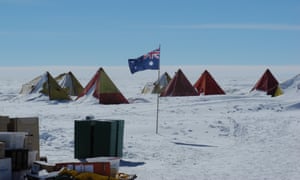Australian Antarctic Division will drill 3,000 metres deep in bid to improve ancient climate records and future models
Antarctic scientists are close to finalising a drilling location deep in the frozen continent’s interior that could reveal a continuous record of the Earth’s climate going back 1.5 million years.
After almost a decade of work, scientists at the Australian Antarctic Division are close to pinpointing a place to drill an ice core almost 3,000-metres deep.
A successful mission would give scientists a reliable record of the Earth’s ancient climate that would be half a million years or more older than current ice core records.
Daily temperatures average -51C (-60F) at the location, known as Little Dome C, which is about 1,100km inland from Australia’s Casey research base.
The continent’s ancient ice contains air bubbles trapped and sealed off over millennia that work like tiny time capsules of the composition of the Earth’s atmosphere.
Ice cores have been a key tool for the world’s climate scientists to understand what has happened to the Earth’s climate in the past and what could happen in the future as greenhouse gas levels from fossil fuel burning continue to rise.
The area around Little Dome C is about 40 kilometres away from Dome C – also known as Dome Concordia – which is the site of the longest continuous ice core record so far, going back about 800,000 years.
A Europe-backed effort that has worked closely with the Australian team has already pinpointed a drill site in the same Little Dome C region.
Dr Joel Pedro, an expert in ancient climates, is lead project scientist at the Million Year Ice Core Project at the Australian Antarctic Division.
He said the selection of the site would be the culmination of almost a decade of work.
“We haven’t thrown the dart just yet and we’re doing modelling work,” he told the Guardian. “We have it down to within four or five kilometres and we’ll be refining it within the next months before we decide and then commit.”
Pedro said there were hopes for a pilot drill operation to start near the end of 2021, but some logistical challenges could delay the efforts.
Pedro said. “We will be pushing the limits of the technology for our measurements, and our drill, and our ability to get out there.”
About 300 tonnes of equipment will need to be transported to the site, which is about 3,000 metres above sea level. A drill will attempt to drive down about 2,800 metres to get to the oldest ice estimated to be between 1.2m and 1.5m years old.
Several summers of drilling will be needed to get to the oldest ice, with one three-metre section taking two hours to retrieve once the drill nears its deepest limits.
At its deepest sections, Pedro said about 14,000 years of snowfall are compressed into each metre of ice.
Ice as old as 2.7m years has been recovered from Antarctica, but this ice did not come from a continuous ice core, leaving long data gaps.
Extending the ice core record from 800,00 years to as distant as 1.5m years would reveal how the atmosphere’s composition changed during a period known as the Middle Pleistocene Transition (MPT) when the time between ice ages switched from 41,000-year cycles to 100,000 years.
Pedro said it was currently an open question about why the Earth’s ice age cycles shifted. But the ice core would reveal “fundamental information about [the Earth’s] sensitivity to CO2.”
Old ice, future climate models
Prof Carlo Barbante, who is co-ordinating the European effort, said in partnership with Australian and US researchers, more than 4,000 kilometres of radar measurements from planes and the ground had been taken as part of the search.
The old ice had accumulated in the area because snowfall was relatively low, temperatures were extremely cold, and there was little heat coming from the bedrock below.
This is of utmost importance to more reliably predict the future of our climate
Barbante, of Italy’s Institute of Polar Sciences, said understanding what happened during the MPT “has a lot of implications for today’s climate and in particular to the sensitivity of our planet to the changes in CO2 concentrations.”
He said the changes to the cycles of the ice ages was “one of the most enigmatic riddles of the climate system” and answering why it happened would “considerably improve our understanding of the way the climate system works.”
He added: “This is of utmost importance to more reliably predict the future of our climate, beyond the next decades, beyond 2100, to understand the long-term consequences for civilisation and humanity of our current fossil-fuel burning activities.”
Pedro said that as well as revealing the levels of greenhouse gases in the atmosphere and how they changed, the analysis would also look for other gases – xenon and krypton – that can be analysed to estimate ocean temperatures.
Having a parallel European effort was important, Pedro said, because it would allow results to be compared and give scientists extra confidence in their results.
Pedro is slated to be part of the team sent to the site. He has previously worked on Antarctica and likened the conditions to experiencing “a whole new force of nature”.
Conditions at Little Dome C would be “cold as hell,” he added. “People have compared this to doing science in space.”
Dr David Etheridge, a climate scientist at CSIRO, has undertaken several polar drilling projects, but he said the conditions at Little Dome C would be “harder, colder and deeper” than previous efforts.
He said the prospects of obtaining a 1.5m-year-old ice core was a major human challenge, but would deliver vital knowledge to improve global climate models.
Pedro updated Australia’s climate science community on the ice core project in a presentation on Friday during the annual conference of the Australian Meteorological and Oceanographic Society, which was held virtually.
.png)

No comments:
Post a Comment